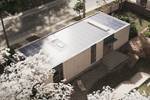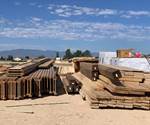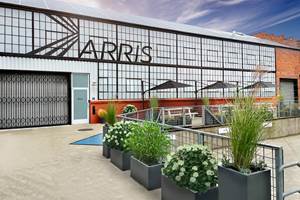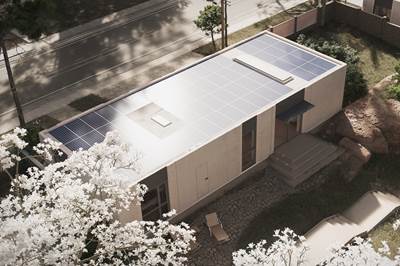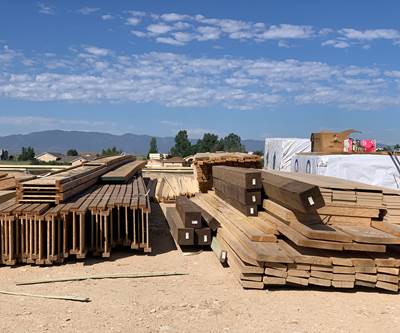
A prototype of Mighty Buildings’ two-bedroom, 864-square-foot Mighty Trio modular home, built with continuous glass fiber-reinforced, 3D-printed panels. Construction for Mighty Trio homes, and other homes available as part of the Mighty Kit System, are expected to begin by the end of this year. Photo Credit, all images: Mighty Buildings
Last summer, Mighty Buildings Inc. (Oakland, Calif., U.S.) officially launched Mighty Mods, its 3D-printed, prefabricated modular accessory dwelling units (ADU), which are manufactured via a combination of additively manufactured thermoset resin panels and steel frames.
Now, in addition to selling and building Mighty Mods using the company’s extrusion- and UV-cure-based large-format additive manufacturing process, in 2021 the company is focusing on UL 3401 certification of a continuous glass fiber-reinforced version of its thermoset Light Stone Material (LSM). This will enable Mighty Buildings to begin building and selling its next product: the Mighty Kit System (MKS).
Mighty Mods are 350- to 700-square-foot, single-story structures that are printed and assembled at the company’s California facility and delivered ready-to-install via crane. According to Sam Ruben, chief sustainability officer (CSO) at Mighty Buildings, as the company looks to expand to customers outside of California and to building larger structures, there are inherent transportation limitations to shipping these ready-made structures. Therefore, the Mighty Kit System will include structural panels and other construction materials shipped for on-site assembly using basic construction equipment. The Mighty House product line is the first to use the Mighty Kit System and was developed in partnership with EYRC Architects and Buro Happold Engineering.

A rendering of a fully constructed Mighty Trio home.
The Mighty House line, all single-story, will range from 400-square-foot, one-bedroom ADUs up to 1,440-square-foot, three-bedroom, two-bath family homes. Ruben adds that contracts and orders have already begun coming in for these structures, and the company hopes to begin construction by the end of this year once all of the proper certifications are in place.
In addition, all Mighty Kits will use 3D-printed, fiber-reinforced thermoset composite structural panels. Ruben says that the fiber reinforcement enables parts made with the material to “have similar characteristics to reinforced concrete of the same size, with four times less weight and over four times better insulation.” The proprietary thermoset LSM has also been reformulated to be more sustainable, Ruben adds. This includes reducing the amount of binder, which he says allows them to reduce the total amount of polymer required to print the part, and the incorporation of recycled glass beads and other more sustainable fillers. “These allow us to deliver high performance in terms of structural quality and fire-performance while also maximizing material usage and meeting our sustainability goals,” he says.
Ultimately, Ruben says that the fiber-reinforced panels will enable the company to expand into multi-story single-family homes, multi-family townhouses, and three- to six-story low-rise apartment buildings. “We hope to start building demonstrator structures next year for these as well,” he says.
Next steps for the material include fire resistance, compression and tensile strength and temperature tests moving toward certification. Another 2021 goal for Mighty Buildings, Ruben says, is the identification of the company’s next manufacturing location — called a “Mighty Factory,” to enable the company to work more closely with builders outside of California and to manufacture components closer to high-demand areas.
Related Content
Watch: A practical view of sustainability in composites product development
Markus Beer of Forward Engineering addresses definitions of sustainability, how to approach sustainability goals, the role of life cycle analysis (LCA) and social, environmental and governmental driving forces. Watch his “CW Tech Days: Sustainability” presentation.
Read MoreASCEND program update: Designing next-gen, high-rate auto and aerospace composites
GKN Aerospace, McLaren Automotive and U.K.-based partners share goals and progress aiming at high-rate, Industry 4.0-enabled, sustainable materials and processes.
Read MorePlant tour: Arris Composites, Berkeley, Calif., U.S.
The creator of Additive Molding is leveraging automation and thermoplastics to provide high-volume, high-quality, sustainable composites manufacturing services.
Read MoreCirculinQ: Glass fiber, recycled plastic turn paving into climate solutions
Durable, modular paving system from recycled composite filters, collects, infiltrates stormwater to reduce flooding and recharge local aquifers.
Read MoreRead Next
3D-printed prefab homes aim to disrupt construction market
California startup Mighty Buildings’ award-winning prefabricated building production process relies on large-format 3D printing, UV-curable resins, digital design and automation.
Read MoreHome building with composites
There’s a house being built next door. It could be using more composites.
Read More“Structured air” TPS safeguards composite structures
Powered by an 85% air/15% pure polyimide aerogel, Blueshift’s novel material system protects structures during transient thermal events from -200°C to beyond 2400°C for rockets, battery boxes and more.
Read More

.jpg;width=70;height=70;mode=crop)
